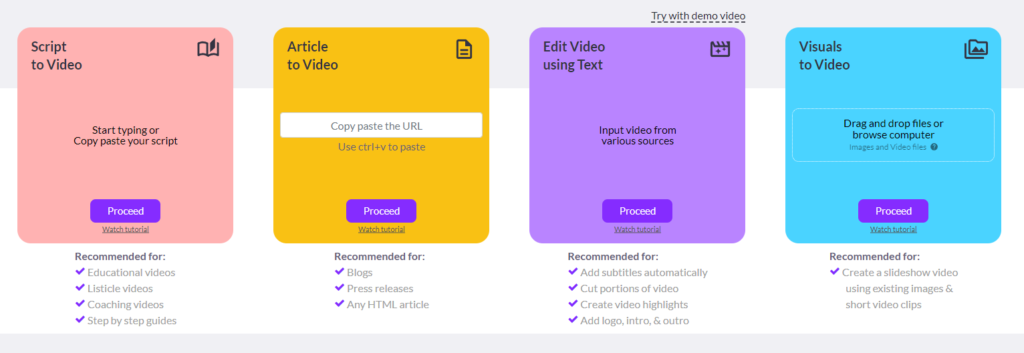1. Introduction
When it comes to choosing the right video editing tool, the comparison of Invideo vs Pictory often emerges as a hot topic among content creators and marketers. Both platforms have carved a significant niche in the industry, touting a range of features tailored to optimize and elevate the video-making journey. As we delve into this comprehensive review, we aim to shed light on the strengths, weaknesses, and standout aspects of each platform, guiding you to a decision that best aligns with your creative aspirations.
Table of Contents
2. Pricing: Invideo vs Pictory
When venturing into the world of video editing, pricing is often a paramount concern. As you compare Invideo vs Pictory, it’s essential to consider not just the cost but also the features offered at each price point. Both platforms provide competitive prices, but your specific needs will determine which offers better value. It’s a wise move to assess the required features, frequency of use, and budget constraints before diving deeper into their respective pricing structures.
Invideo’s Pricing Structure
Invideo offers a tiered pricing structure, catering to both beginners and professional video editors. These are typically divided into:
- Free Tier: This is a basic package for those who are just starting out. While it offers a range of features, there are certain limitations in terms of templates, export quality, and watermarking.
- Paid Plans: Ranging from monthly to yearly subscriptions, these plans are designed to meet the diverse needs of users. They often come with added benefits like premium templates, higher export quality, and faster rendering time.

Pictory’s Pricing Dynamics
Pictory has its unique approach to pricing, ensuring that users get value for their investment:
- Trial Offer: Pictory often starts with a limited-time trial offer, giving potential users a taste of its capabilities without any upfront payment.
- Subscription Packages: Similar to Invideo, Pictory also has different subscription levels. Each package is crafted with a particular user base in mind, from casual video enthusiasts to large enterprises requiring advanced features.[Image: A detailed infographic showcasing Pictory’s subscription packages and their inclusions]

Pricing is more than just numbers—it’s about the value, features, and potential growth your chosen platform can provide. Whether you lean towards Invideo or Pictory, make an informed decision based on a comprehensive understanding of their pricing structures.
3. User Interface and Usability: Invideo vs Pictory
In the dynamic world of video editing software, the importance of an intuitive user interface and robust usability cannot be overstated. As users ponder the strengths of Invideo vs Pictory, understanding how each platform approaches design and user experience becomes crucial. Both tools offer innovative features, but it’s their approach to usability that can make all the difference to end-users.
Invideo’s User Interface
Invideo stands out with its contemporary and streamlined interface, catering to both novices and seasoned pros:
- Dashboard Overview: Immediately upon login, users are greeted with a clear and organized dashboard, ensuring quick access to all essential features.
- Drag-and-Drop Functionality: Catering to those with minimal editing background, this feature simplifies the video creation process, allowing users to position elements precisely where they want.
- Tutorial Pop-ups: For those new to the platform, Invideo offers guiding tutorial pop-ups, ensuring users can swiftly familiarize themselves with the tool.

Pictory’s Approach to Usability
Not to be outdone, Pictory presents a usability experience that champions simplicity and focus:
- Minimalist Design: By adopting a clutter-free and minimalist design, Pictory ensures that users can concentrate fully on crafting their video narratives.
- Step-by-Step Process: The video creation journey is broken down into bite-sized steps, ensuring even those new to video editing can navigate the process with confidence.
- Quick Access Toolbar: With Pictory, essential tools are never more than a click away, thanks to its handy and efficiently designed toolbar.

When deciding between Invideo and Pictory, potential users should reflect on their personal preferences:
- Do you value having a comprehensive dashboard available immediately, as provided by Invideo?Or
- Do you lean towards a methodical, step-by-step approach, as championed by Pictory?
4. Features and Capabilities: Invideo vs Pictory
When assessing video editing software, features and capabilities stand at the forefront of any decision-making process. Understanding what each platform offers in terms of functionality can be a game-changer for users, from freelancers to business entities. Let’s dive deep into the comparison of Invideo vs Pictory on these parameters.
Invideo’s Feature Set
Invideo comes packed with a range of functionalities tailored to enhance the video editing experience:
- Dynamic Templates: With a vast library of templates, Invideo allows users to jumpstart their projects, be it promotional videos, presentations, or personal clips.
- Advanced Editing Tools: Beyond the basics, Invideo offers color correction, audio adjustments, and motion graphics capabilities, providing depth to any project.
- Collaboration Features: For teams, Invideo’s collaboration tools ensure smooth communication and joint project handling.

Pictory’s Capabilities
Pictory, while having its distinct approach, ensures a rich feature set for its users:
- Automated Video Creation: One of Pictory’s standout features is its ability to convert articles or blogs into videos, streamlining content repurposing.
- Customizable Themes: Pictory offers themes that can be tweaked to align with brand guidelines, ensuring consistency across all video content.
- Audio Library: Pictory houses an expansive library of music and sound effects, giving depth and emotion to any video narrative.

Invideo vs Pictory: Features Face-Off
Comparing Invideo vs Pictory, it’s evident that while both platforms offer a robust set of tools, their focal points differ. Invideo leans towards detailed video crafting and collaboration, whereas Pictory emphasizes automation and brand consistency.
While these platforms offer distinctive video editing features, if you’re also interested in design tools, our Canva vs Figma comparison offers insights into the top graphic design platforms.
5. AI Tools: Invideo vs Pictory
When discussing the integration of AI in video editing tools, the Invideo vs Pictory comparison becomes particularly intriguing. Both contenders showcase their unique strengths in the AI department: Invideo appears more geared towards optimizing the traditional video editing process with AI, while Pictory focuses on transforming content types and automating video creation.
Invideo’s AI Arsenal
Invideo leverages AI to simplify and enhance video creation:
- Automated Video Assembly: Based on the content provided, Invideo’s AI suggests optimal video sequences, helping create fluid and engaging narratives.
- Intelligent Template Recommendation: Depending on the nature of the project, Invideo’s AI recommends the best-fitting templates, ensuring stylistic coherence.
- Smart Audio Sync: The AI detects the video’s pace and rhythm, automatically aligning background music to enhance the overall mood.

Pictory’s AI Innovations
Pictory, too, boasts an impressive AI toolkit tailored to its user base:
- Content-to-Video Transformation: Pictory’s AI can transform textual content, like blogs or articles, into visual stories, automating much of the video creation process.
- AI-Powered Scene Selection: The platform assesses the content’s tone and context, suggesting appropriate scenes or backdrops.
- Automated Voiceovers: Pictory’s AI can generate voiceovers based on the provided script, adding a professional touch to videos without manual recording.

6. Performance and Speed: Invideo vs Pictory
Waiting ages for a tool to respond or enduring lag can be frustrating. How do Invideo and Pictory stack up against each other when it comes to these crucial factors? Let’s dive into the performance metrics of Invideo vs Pictory.
Invideo’s Performance Metrics
Performance in Invideo is lauded for its robustness and responsiveness:
- Quick Render Times: Invideo’s infrastructure ensures that videos, regardless of their complexity, are rendered quickly, reducing wait times for users.
- Smooth Playback: Users often commend Invideo for its seamless playback experience, even with HD or 4K content.
- Efficient Cloud Storage: Invideo offers cloud storage, ensuring projects are saved and backed up promptly, eliminating concerns over lost work.
Pictory’s Speed Quotient
Pictory isn’t left behind in the race for efficiency:
- Rapid Conversion: One of Pictory’s standout features is its swift conversion of text to video, making content repurposing a breeze.
- Optimized Workflows: Pictory’s interface is designed for speed, with tools and functions arranged for quick access and reduced project turnaround times.
- Server Performance: Pictory ensures that server downtimes or lags are minimal, allowing users to work without interruptions.
Invideo vs Pictory: Speed and Performance Face-Off
When evaluating Invideo vs Pictory in terms of speed and performance, both platforms display their strengths. Invideo shines with its rendering and playback prowess, while Pictory impresses with its rapid conversion and workflow optimization.
7. Collaboration and Sharing: Invideo vs Pictory
In today’s interconnected world, the ability for teams to collaborate seamlessly on projects and easily share their creations is essential. Both Invideo and Pictory recognize this need. Here, we evaluate the collaboration and sharing capabilities of Invideo vs Pictory to help you decide which platform best supports team-oriented projects.
Invideo’s Collaboration Capabilities
Invideo is more than just a video editor; it’s a platform designed for teamwork:
- Team Projects: Invideo allows multiple users to work on a single project. Team members can be given specific roles and permissions to streamline the editing process.
- Real-time Collaboration: Invideo’s interface supports real-time edits, meaning team members can see changes made by their peers instantaneously. This boosts productivity and ensures consistency across the board.
- Shareable Links: Once a project is complete, users can generate shareable links. These links provide access to the video, enabling easy feedback collection or simple sharing to social media platforms.

Pictory’s Sharing Solutions
Pictory, with its unique approach to video creation, doesn’t lag in the collaboration department:
- Shared Workspaces: Pictory offers dedicated workspaces where teams can group their projects. This allows for easier management and ensures everyone stays on the same page.
- Commenting System: Integrated directly within the platform, team members can leave comments on specific sections of a video. This fosters constructive feedback and ensures all perspectives are considered.
- Export Options: Pictory offers a plethora of export options catering to different platforms. Whether you’re sharing on YouTube, Instagram, or directly through email, Pictory ensures your video is in the right format and resolution.

Invideo vs Pictory: Collaboration and Sharing Showdown
When dissecting the collaboration and sharing aspects of Invideo vs Pictory, it’s evident both platforms are built with teams in mind. Invideo excels in real-time collaboration, ensuring a synchronous workflow, while Pictory shines with its structured workspaces and detailed feedback mechanisms.
In conclusion, your choice between the two might hinge on your team’s specific collaboration needs and your preferred methods of sharing and gathering feedback.
8. Platform Compatibility and Integration: Invideo vs Pictory
In the vast digital ecosystem, compatibility with various devices and the ability to integrate with other software tools can be a game-changer. No one wants to be restricted to a single device or miss out on connecting their favorite apps for a smoother workflow. Hence, a detailed look into the platform compatibility and integration of Invideo vs Pictory is essential.
Invideo’s Compatibility Credentials
Invideo, with its evolving ecosystem, has taken steps to be versatile:
- Cross-Platform Access: Invideo is cloud-based, allowing users to access their projects from various devices – be it a laptop, tablet, or even a smartphone. The responsive design ensures a consistent experience across devices.
- Integration with Stock Libraries: Invideo seamlessly integrates with stock libraries like Unsplash and Pexels, making it easier for users to fetch high-quality images and videos for their projects.
- API Access: For businesses and advanced users, Invideo provides API access, facilitating integration with other tools and custom applications.
Pictory’s Integration Innovations
Pictory, though focused on a unique content transformation approach, ensures it doesn’t lack in compatibility:
- Web-Based Solution: Pictory is a web-based platform, ensuring users can create and edit videos from any device with a browser. This flexibility is a boon for teams spread across different locations or on the move.
- Social Media Compatibility: Recognizing the importance of social media marketing, Pictory ensures videos are exportable in formats optimized for platforms like Instagram, Facebook, and Twitter.
- Third-party App Integrations: Pictory smoothly integrates with content management systems and other third-party apps, enhancing its usability for content creators and marketers.
Invideo vs Pictory: Compatibility and Integration Face-Off
Both Invideo and Pictory showcase a commitment to ensuring a broad user base can access their tools without hassle. While Invideo’s strengths lie in its API access and stock library integrations, Pictory stands out with its strong emphasis on social media compatibility and content management system connections.
In wrapping up, your decision between Invideo and Pictory might come down to where and how you plan to use the platform most frequently and which integrations align more with your workflow needs.
9. Pros and Cons: Invideo vs Pictory
When choosing between digital tools, understanding their strengths and weaknesses is crucial to making an informed decision. Here, we provide a balanced assessment of the pros and cons of Invideo vs Pictory, laying out the distinctive advantages and potential drawbacks of each platform.
Invideo Pros
- User-friendly Interface: Designed for both beginners and professionals, Invideo offers an intuitive interface that simplifies the video creation process.
- Robust Feature Set: From text-to-video capabilities to advanced editing tools, Invideo boasts a comprehensive suite of features catering to various needs.
- High-Quality Templates: With a wide range of pre-designed templates, users can quickly get started and produce visually appealing videos.
- Flexible Pricing Options: Catering to both individual creators and businesses, Invideo offers varied pricing tiers to match different budget constraints.
- Real-time Collaboration: The ability to collaborate in real-time with team members sets Invideo apart, enhancing team productivity.
Invideo Cons
- Learning Curve for Advanced Features: While it’s user-friendly, mastering Invideo’s advanced tools might require some time for complete beginners.
- Limited Free Version: The free version of Invideo comes with watermarks and has restricted access to premium templates.
Pictory Pros
- Swift Text-to-Video Conversion: Pictory’s primary strength lies in its ability to swiftly convert textual content into engaging videos.
- Optimized for Social Media: The platform ensures content is ready for social media platforms, eliminating the need for manual adjustments.
- Commenting System: The integrated feedback system is a boon for teams, ensuring all input is considered during the editing process.
- Diverse Export Options: Pictory supports various export resolutions and formats, making it versatile for different platforms.
- Integration with CMS: For content marketers, the ability to integrate with content management systems is invaluable.
Pictory Cons
- Less Advanced Editing Tools: Compared to some competitors, Pictory might lack in-depth video editing features.
- Subscription Model: There’s no one-time purchase option, which might not appeal to users who prefer such pricing structures.
Invideo vs Pictory: PROS AND CONS Verdict
Both Invideo and Pictory have their merits and drawbacks. While Invideo shines with its comprehensive features and collaboration options, Pictory is the go-to for swift text-to-video transformations and social media optimization. Potential users should weigh these pros and cons against their specific needs and preferences to make the right choice.
10. Discover the 5 Secrets
1. Advanced Automation in Pictory
Secret Unveiled: Pictory harnesses the power of AI to automatically extract key scenes from longer videos, making clip creation a breeze.
Benefit: This reduces manual effort and speeds up the content creation process, allowing users to focus on creativity rather than editing minutiae.
2. Dynamic Templates in Invideo
Secret Unveiled: Invideo boasts a vast library of customizable templates that adapt dynamically to the content you input.
Benefit: This ensures that regardless of the content length or type, it always looks professional and engaging without additional tweaking.
3. Seamless Integration Options with Pictory
Secret Unveiled: Pictory isn’t just an isolated tool; it integrates seamlessly with various content management systems and social platforms.
Benefit: This simplifies the workflow for content creators and marketers, enabling direct publishing without the need for intermediate steps.
4. Real-time Collaboration in Invideo
Secret Unveiled: Invideo supports real-time collaboration, allowing teams to edit and review videos simultaneously, just like they would on a document.
Benefit: This enhances team productivity, cuts down revision times, and ensures a unified vision in the final product.
5. Cost-Effective Scalability with Both Platforms
Secret Unveiled: Both Invideo and Pictory offer enterprise-grade solutions that are surprisingly affordable, enabling scalability without breaking the bank.
Benefit: As businesses grow, they won’t face sudden spikes in costs. They can confidently scale their video marketing efforts while keeping costs predictable.
11. Conclusion
In the vast landscape of video creation tools, both Invideo and Pictory have carved a niche for themselves, offering distinctive features tailored to meet specific user needs. In the face-off of Invideo vs Pictory, the decision boils down to individual preferences and project requirements.
For those seeking advanced editing capabilities, collaboration tools, and a rich set of features, Invideo might be the better pick. Conversely, if rapid text-to-video conversion, social media optimization, and seamless integration with content management systems are priorities, Pictory emerges as the stronger candidate.
Ultimately, both platforms excel in their own right, and the best choice will vary from one user to the next. As with any tool, the most effective way to determine its fit is to explore it firsthand. Both Invideo and Pictory offer trial versions, allowing prospective users to test drive their capabilities before making a commitment. By aligning tool functionalities with personal or business needs, one can confidently select the platform that promises the most value and efficiency.


